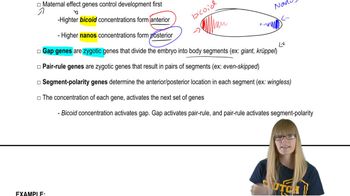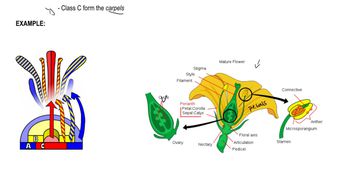Table of contents
- 1. Introduction to Genetics51m
- 2. Mendel's Laws of Inheritance3h 37m
- 3. Extensions to Mendelian Inheritance2h 41m
- 4. Genetic Mapping and Linkage2h 28m
- 5. Genetics of Bacteria and Viruses1h 21m
- 6. Chromosomal Variation1h 48m
- 7. DNA and Chromosome Structure56m
- 8. DNA Replication1h 10m
- 9. Mitosis and Meiosis1h 34m
- 10. Transcription1h 0m
- 11. Translation58m
- 12. Gene Regulation in Prokaryotes1h 19m
- 13. Gene Regulation in Eukaryotes44m
- 14. Genetic Control of Development44m
- 15. Genomes and Genomics1h 50m
- 16. Transposable Elements47m
- 17. Mutation, Repair, and Recombination1h 6m
- 18. Molecular Genetic Tools19m
- 19. Cancer Genetics29m
- 20. Quantitative Genetics1h 26m
- 21. Population Genetics50m
- 22. Evolutionary Genetics29m
14. Genetic Control of Development
Developmental Patterning Genes
Problem 29c
Textbook Question
Textbook QuestionIn Drosophila, recessive mutations in the fruitless gene (fru) result in males courting other males; and recessive mutations in the Antennapedia gene (Ant⁻) lead to defects in the body plan, specifically in the thoracic region of the body, where mutants fail to develop legs. The two genes map 15 cM apart on chromosome 3. You have isolated a new dominant Antdᵈ mutant allele that you induced by treating your flies with X-rays. Your new mutant has legs developing instead of antennae on the head of the fly. You cross your newly induced dominant Antᵈ mutant (a pure-breeding line) with a homozygous recessive fru mutant (which is homozygous wild type at the Ant⁺ locus), as diagrammed below: What phenotypes, and in what proportions, do you expect in the F₂ obtained by interbreeding F₁ animals?
 Verified Solution
Verified SolutionThis video solution was recommended by our tutors as helpful for the problem above
Video duration:
2mPlay a video:
211
views
Was this helpful?
Related Videos
Related Practice


